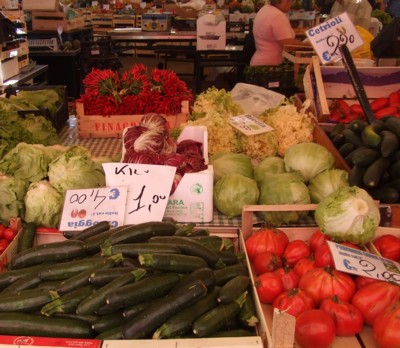The Rialto area was the first part of Venice to be developed, and it soon became a centre for commerce. The town’s principal market was transferred here at the end of the eleventh century. Trading of all kinds took place, and this would be where Venetians and merchants could buy and sell exotic imported goods just unloaded from ships. In the sixteenth century, after a destructive fire, a complex of squares and porticoes was constructed to the west of the Rialto Bridge, with areas dedicated to different products. These are still recorded in the names of the local lanes and squares: Erberia (fruit and vegetable market), Naranzeria (oranges), Speziali (spices) and Pescaria (fish). Fish, fruit and vegetables are still sold here, from a colourful array of stalls where you can buy provisions or just admire the spectacle. The fish market is housed in a covered hall, the Pescheria, with fishy decorative features.
If you’ve read many books about Venice, you may expect the Rialto markets to be filled with whimsical US expats swapping life-stories and culinary tips with folksy stall-holders. Happily, there is still some authentic local atmosphere to be savoured. The old ladies from Cannaregio cross the Grand Canal on the vaporetto or the little traghetto gondola with their shopping trolleys each morning, and the markets are still a place where local people can shop for their daily food requirements at reasonably low prices. For tourists, it’s a good chance to stock a rented kitchen or to prepare a cheap and healthy picnic.
Food shopping is a daily activity in Italy, and produce is expected to be very fresh. Here at the Rialto, many of the fruit and vegetables come, as they have always done, from the nearby island of Sant’Erasmo, so they haven’t had far to travel at dawn. Produce is all labelled with its place of origin; if not the lagoon islands or the surrounding countryside of the Veneto, it is likely to be from elsewhere in Italy.
The markets are open in the mornings from Monday to Saturday; the fish market is closed on Mondays. Shoppers generally arrive as early as they can, jostling for service and fighting through camera-toting tourists. In the late morning you’ll still find the fruit and veg stalls, though some of the fishmongers will have packed up. There are also several good food stores around the market area, selling gourmet foodstuffs, oils, wine, pasta and regional specialities.
The markets are located alongside the Grand Canal, to the north-west of the Rialto Bridge in the district of San Polo (the opposite side to San Marco). From the Rialto walk straight on, then dodge to the right through the lines of souvenir stalls. Pick your way through the colonnaded squares of the historic markets and you’ll find yourself where the action is. On weekday daytimes the vaporetto number 1 stops alongside, at the Rialto Mercato stop. A gondola traghetto operates a ferry service across the canal to Campo Santa Sofia on the Strada Nova.
